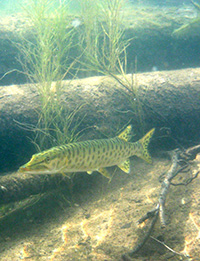Fish sticks: Improving lake habitat
Fishing Wisconsin
Trees have been dropping naturally into Wisconsin lakes since the glaciers receded. Fallen trees provide shelter and feeding areas for a diversity of fish species and may also provide nesting and sunning areas for birds, turtles and other animals above the water. Nearly all fish species use woody habitats for at least a portion of their life cycle.
What are fish sticks?
“Fish Sticks” projects are intended to restore woody habitat in lakes by adding trees to the near-shore area. They are large woody habitat structures that use either single trees or trees grouped. Fish sticks structures are anchored to the shore and are partially or fully submerged near the shoreline of a lake. Fish sticks projects are completed to provide additional fish habitat, as well as to expand fishing opportunities by anglers and provide protection to shorelines. Additional information on fish sticks and the fish sticks implementation process can be found in the Fish Sticks Best Practices Manual.
Fish sticks projects generally include a variety of cooperators: lakefront property owners, lake associations or districts, DNR permitting and fisheries staff, county land and water conservation departments and possibly federal agencies.
How can I get involved in a fish sticks project?
- Fish sticks projects are permitted through a general permit process.
- Contact your local fisheries biologist for recommendations.
How do I apply for a fish sticks project?
You can apply for a fish sticks project through the online permitting process.
Fish sticks funding: Healthy Lakes grants
The statewide Healthy Lakes initiative funds simple best practices like fish sticks, native plantings, and rain gardens on lakeshore properties. Eligible applicants include local governments, qualified lake associations, lake districts, and non-profit conservation organizations that sponsor projects on behalf of individual property owners. Learn more at the healthy lakes initiative website.
Fish sticks literature
- A second life for trees in lakes: as useful in water as they were on land
- Impacts of lakeshore residential development on coarse woody debris in north temperate lakes
- Lakeshore woody habitat in review
- Less work, more beauty, better protection - Wisconsin Natural Resources magazine, April 2000
- Natural and anthropogenic variation in coarse wood among and within lakes
- Fish community and food web responses to a whole-lake removal of coarse woody habitat
- Is littoral habitat affected by residential development and land use in watersheds of Wisconsin lakes?
- Largemouth bass nest site selection in small, north temperate lakes varying in littoral coarse woody habitat abundances

